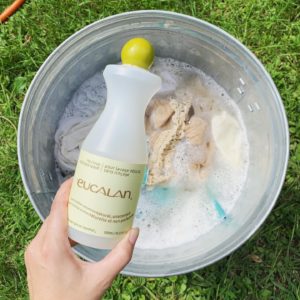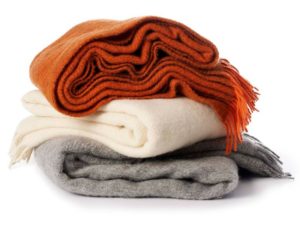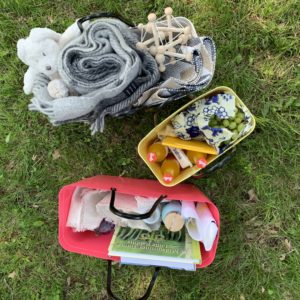Wool and How to Care for It

Every year in April, we are reminded of our environmental goals. How can we keep reaching for more? Ingebretsen’s has always been very intentional with the brands and makers that are represented in the store and online; and we have gathered some favorite sustainable goods here. This year, we are also thinking about the materials and goods that are at the core of the Nordic culture of sustainability. And one of our favorite sustainable materials is wool!
Wool keeps us warm and dry. Some of us have wool items that have survived for generations: sweaters, blankets, and weavings. But what is wool and why do we choose it again and again for our garments? The Laundress defines wool as, “An elastic fiber derived from the sheep, goat, camel, alpaca, llama, rabbit, keeshond or vicuña. Wool is fire retardant and resistant to water, odor, and stains. The crimp retains heat and repels cold.” The natural fibers from animals have a layer of keratin, a protein that helps maintain body temperature. Wool repels water and dirt and has been used by fisherman, farmers, and skiers for centuries. Take good care of wool and it will last a lifetime (or longer)!
Wash
Most manufactured clothing items and wool pieces, like blankets, will indicate the best cleaning method. Wash on cold cycle or delicate cycle if machine does not have specifics for wool.

For extra precaution, you can turn garments inside out and put them in a delicate washing bag. Many wool items are dry-clean or hand-wash only and handwashing is the safest method, especially if you’re unsure or if the garment is handmade or without a tag. Using a wool wash, like Eucalan (which is no-rinse for added ease), add the recommended amount to a sink or basin with tepid water and agitate. Soak for up to thirty minutes.
Stains are best treated with a pretreatment before washing. Apply soap to the dry garment and blot well. Continue washing as normal.
Dry
There is a risk of shrinkage in some wool garments. Low tumble dry or a delicate setting can be effective for commercial wool knits. If you’re not sure, or the item is handmade, use a wool wash and air dry flat at room temperature, out of direct sunlight.
Absorb extra moisture for air drying by rolling items in a dry towel (don’t wring if possible), shaping, and then laying flat. Keep out of direct sunlight and away from any direct heat sources.
Store
Make sure wools are properly cleaned before long term storage. Storing in fabric bags (cotton) is better than plastic, as moisture does not get trapped inside and discoloration is less likely.
 Avoid using sharp or thin metal hangers for storage. Wool likes to change its shape. The benefit to this is that wool can be reshaped if it gets out of sorts. Simply soak the item and while damp, press to your desired shape. Let dry flat on a towel.
Avoid using sharp or thin metal hangers for storage. Wool likes to change its shape. The benefit to this is that wool can be reshaped if it gets out of sorts. Simply soak the item and while damp, press to your desired shape. Let dry flat on a towel.
Moths
Wool (plus food or body oils) attracts moths, which will lay eggs in the fibers; those baby moths eat the fibers, creating holes. Cedar balls (which Ingebretsen’s carries from Iris Hantverk), or blocks, repel moths with their scent. Have some old cedar pieces? Revive them with a light sanding and place them in a cotton bag to prevent oil stains on your wool. This is a great option for long term storage. The most common sign of moths is small holes in your wool or cashmere garments.
If you find sign of moths, you have several options:
-
- Place the item in a sealable plastic bag and place in the freezer for 24 hours to kill moth larvae
- Fully clean item, dry cleaning will remove any remaining moth larvae
- Once the item is clean you can mend small holes, which are not noticeable most of the time. Wool thread is best for this!
Another great preventative measure is to place moth traps in any areas where there is a good amount of wool, or at any signs of clothing moths. Look specifically for traps designed to catch “clothing moths.”

Refresh
Air out garments for 24 hours to remove odors (outdoor air is best); steam or hang in a steamy bathroom to remove wrinkles.
For the best wear of your wool, let clothing rest for at least 24 hours after each wear to let the fibers relax.
Ironing – iron wools with steam as needed (use wool setting or medium heat) although simply steaming is best for the long term condition of the wool fibers.
Enjoy your wool for years to come!